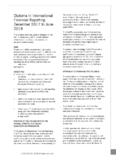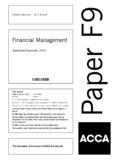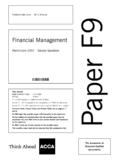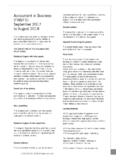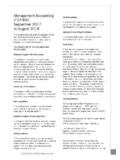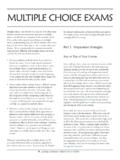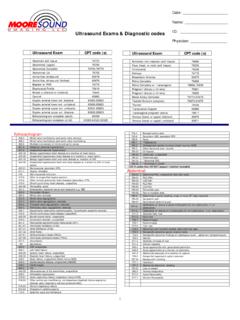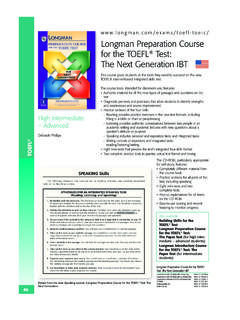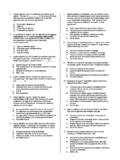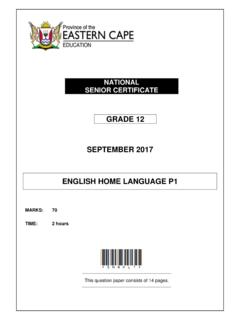Transcription of Paper P3 - Association of Chartered Certified Accountants
1 Paper P3. Professional Pilot Paper Essentials module Business Analysis Time allowed Reading and planning: 15 minutes Writing: 3 hours This Paper is divided into two sections: Section A This ONE question is compulsory and MUST be attempted Section B TWO questions ONLY to be attempted Do NOT open this Paper until instructed by the supervisor. During reading and planning time only the question Paper may be annotated. You must NOT write in your answer booklet until instructed by the supervisor. This question Paper must not be removed from the examination hall. The Association of Chartered Certified Accountants Section A The ONE question in this section is compulsory and MUST be attempted.
2 The following information should be used when answering question 1. 1 Introduction Network Management Systems (NMS) is a privately owned high technology company established in 1997 by computer engineer, Ray Edwards. It is situated in the country of Elsidor, a prosperous developed nation with a stable well- established political system. Successive governments in Elsidor have promoted technology by providing grants and tax incentives. Tax credits are also provided to offset company investment in research and development. The government, like many governments worldwide, have invested heavily in a national telecommunications infrastructure.
3 However, in 2010 the country suffered an economic downturn that led many companies to postpone technological investment. By 2010 NMS employed 75 full-time employees in a new, purpose-built factory and office unit. These employees were a mixture of technically qualified engineers, working in research and development (R&D), factory staff manufacturing and assembling products and a small sales and service support team. Product areas In 2010, NMS had three distinct product/service areas data communication components, network management systems and, finally, technical support. NMS sells data communication components to original equipment manufacturers (OEMs), who use these components in their hardware.
4 Both the OEMs and their customers are predominantly large international companies. NMS has established a good reputation for the quality and performance of its components, which are competitively priced. However, NMS has less than 1% of the domestic marketplace and faces competition from over twenty significant suppliers, most of who also compete internationally. Furthermore, one of the company's OEM customers accounts for 40% of its sales in this area. The international market for data communication components had increased from $33billion in 2001 to $81billion in 2010. Forecasts for 2011 and beyond predict growth from increased sales to currently installed networks rather than from the installation of new networks.
5 The maturity of the technology means that product lifecycles are becoming shorter. Success comes from producing high volumes of reliable components at relatively low prices. NMS produces components in a relatively prosperous country where there is significant legislation defining maximum work hours and minimum wage rates. All new components have to be approved by an appropriate government approval body in each country that NMS supplies. This approval process is both costly and time consuming. The second product area is network management systems. NMS originally supplied fault detection systems to a small number of large end-users such as banks, public utility providers and global manufacturers.
6 NMS recognised the unique requirements of each customer and so it customised its product to meet specific needs and requirements. They pioneered a modular design which allowed customers to adapt standard system modules to fit their exact networking requirements. The success of their product led to it being awarded a prestigious government technology award for technological innovation in data communications . This further enhanced the company's reputation and enabled it to become a successful niche player in a relatively low volume market with gross margins in excess of 40%. They only have two or three competitors in this specialist market.
7 Unlike component manufacture, there is no requirement to seek government approval for new network products. Finally, the complexity of NMS products means that technical support is a third key business area. It has an excellent reputation for this support. However, it is increasingly difficult and costly to maintain the required level of support because the company does not have a geographically distributed network of support engineers. All technical support is provided from its headquarters. This contrasts with the national and international support services of their large competitors. Current issues NMS currently manufacture 40% of the components used in its products.
8 The rest of the components, including semiconductors and microprocessors, are bought in from a few selected global suppliers. Serious production problems have resulted from periodic component shortages, creating significant delays in manufacturing, assembly and customer deliveries. NMS is still a relatively immature organisation. There are small functional departments for sales and marketing, technical research and development, manufacturing and procurement. Ray still personally undertakes all staff recruitment and staff development. He is finding the recruitment of high calibre staff a problem, with NMS' small size and geographical location making it difficult to attract the key personnel necessary for future growth.
9 2. Financial situation In response to poor internal investment decisions, Ray has introduced a more formal approach to quantifying costs and benefits in an attempt to prioritise projects that compete for his limited funds and time. His first formal cost-benefit analysis helped him select a new machine for producing certain components in his factory. The results of his analysis are shown in figure one. The cost of the machine was $90,000, with annual maintenance fees of $5,000. Ray has seen the machine working and he believes that he can save the cost of one technician straight away. These savings are shown as reduced staff costs.
10 The manufacturer of the machine claims that the accuracy of the machine leads to reduced wastage of up to 10% . NMS have detailed measures of the wastage of the current machine and Ray has used this to estimate wastage savings. The increased accuracy of the machine over time is reflected in his estimates. Finally, the manufacturer claims energy savings'. NMS currently know the energy costs of the whole factory but not of individual machines. However, Ray thinks that his estimates for energy savings are realistic. He concludes that over five years the machine breaks even, so this seems a reasonable business case to me.





